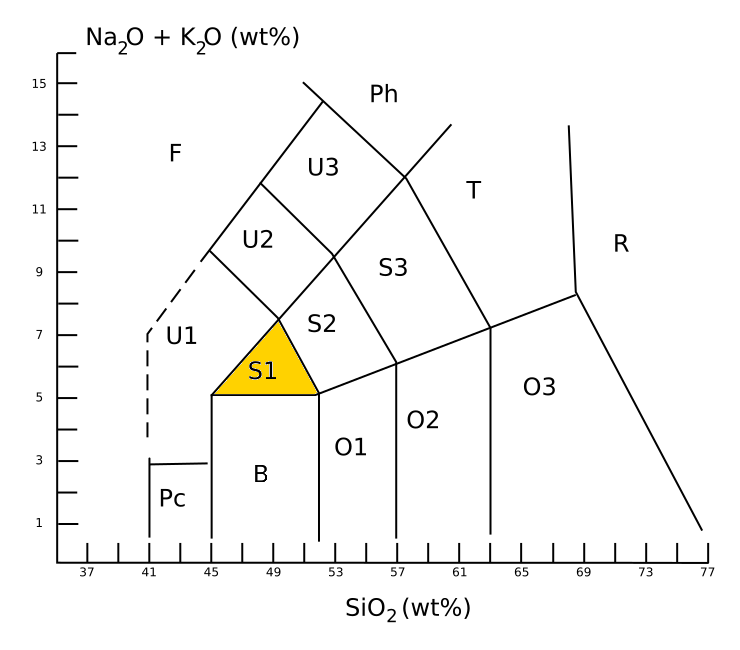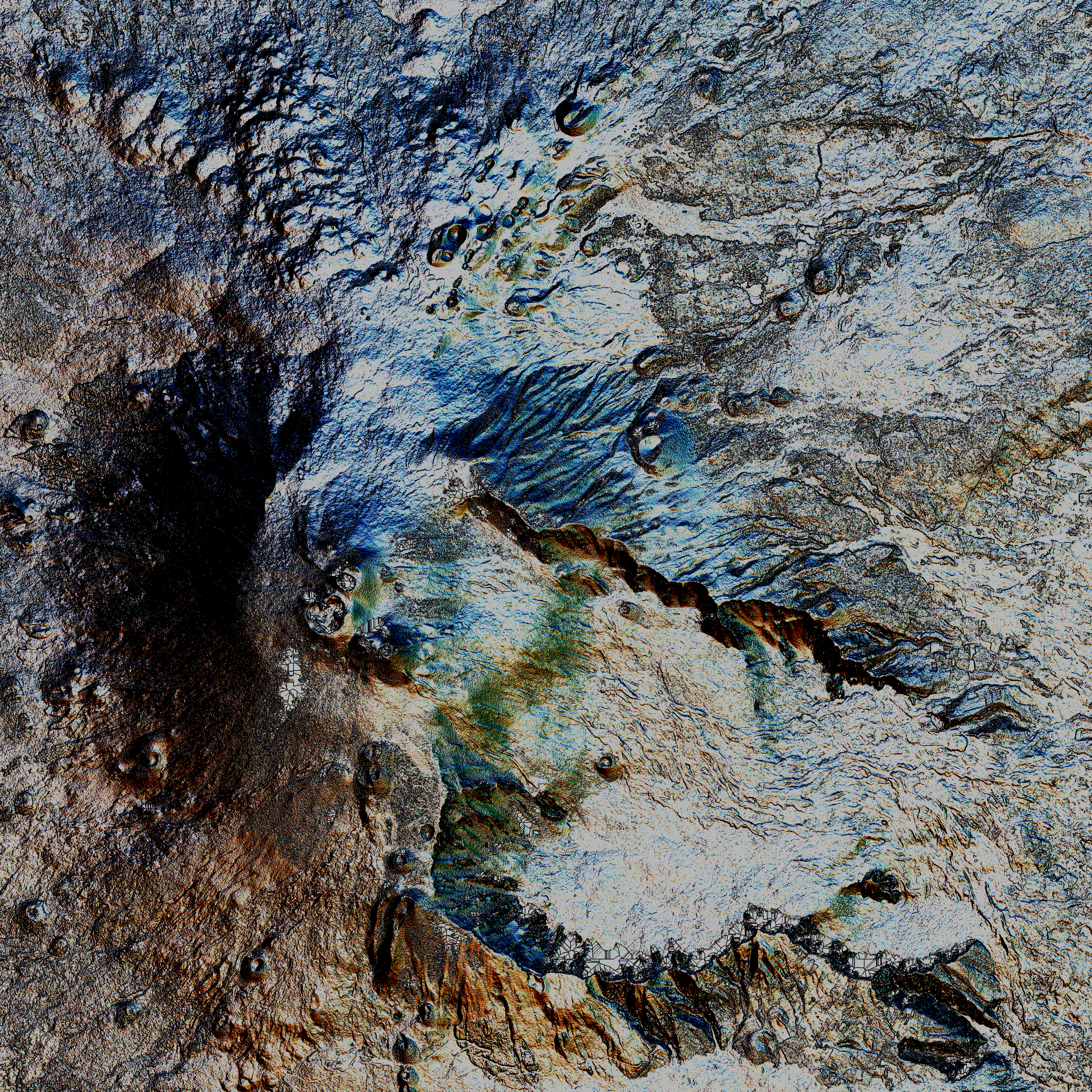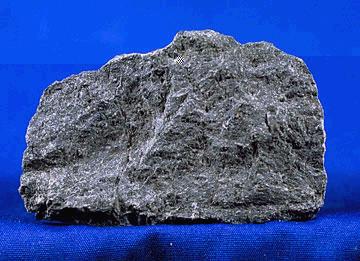|
Trachybasalt
Trachybasalt is a volcanic rock with a composition between trachyte and basalt. It resembles basalt but has a high content of alkali metal oxides. Minerals in trachybasalt include alkali feldspar, calcic plagioclase, olivine, clinopyroxene and likely very small amounts of leucite or analcime. Description An aphanitic (fine-grained) igneous rock is classified as trachybasalt when it has a silica content of about 49% and a total alkali metal oxide content of about 6%. This places trachybasalt in the S1 field of the TAS classification, TAS diagram. Trachybasalt is further divided into sodium-rich ''hawaiite'' and potassium-rich ''potassic trachybasalt'', with wt% > + 2 for hawaiite. The intrusive equivalent of trachybasalt is monzonite. Trachybasalt is not defined on the QAPF diagram, which classifies crystalline igneous rock by its relative content of feldspars and quartz. However, the U.S. Geological Survey defines trachybasalt as a mafic volcanic rock (composed of over 35% ma ... [...More Info...] [...Related Items...] OR: [Wikipedia] [Google] [Baidu] |
TAS Classification
TAS stands for Total Alkali Silica. The TAS classification can be used to assign names to many common types of volcanic rocks based upon the relationships between the combined alkali and silica contents. These chemical parameters are useful because the relative proportions of alkalis and silica are important in determining both normative mineralogy and actual mineralogy. The classification can be simple to use for rocks that have been chemically analyzed. Except for the following quotation from Johannsen (1937), this discussion is based upon Le Maitre et al (2002). Use of the TAS classification Before using the TAS or any other classification, some particular guidance by Johannsen (1937) should be kept in mind. :''Many and peculiar are the classifications that have been proposed for igneous rocks. Their variability depends in part upon the purpose for which each was intended, and in part upon the difficulties arising from the characters of the rocks themselves. The trouble is not w ... [...More Info...] [...Related Items...] OR: [Wikipedia] [Google] [Baidu] |
Analcime
Analcime (; ) or analcite is a white, gray, or colorless tectosilicate mineral. Analcime consists of hydrated sodium aluminium silicate in cubic crystalline form. Its chemical formula is NaAlSi2O6 · H2O. Minor amounts of potassium and calcium substitute for sodium. A silver-bearing synthetic variety also exists (Ag-analcite). Analcime is usually classified as a zeolite mineral, but structurally and chemically it is more similar to the feldspathoids. Analcime is not classified as an isometric crystal, as although the crystal structure appears to be isometric, it is usually off only by a fraction of an angle. However, there are truly isometric samples of the mineral, which makes its classification even more difficult. Due to the differences between the samples being too slight, there's no merit from having multiple species names, so as a result analcime is a common example for minerals occurring in multiple crystal systems and space groups. It was first described by French geolog ... [...More Info...] [...Related Items...] OR: [Wikipedia] [Google] [Baidu] |
Vesicular Lava (July-August 2001 Eruption Of Mt
Vesicle may refer to: ; In cellular biology or chemistry * Vesicle (biology and chemistry), a supramolecular assembly of lipid molecules, like a cell membrane * Synaptic vesicle In a neuron, synaptic vesicles (or neurotransmitter vesicles) store various neurotransmitters that are exocytosis, released at the chemical synapse, synapse. The release is regulated by a voltage-dependent calcium channel. Vesicle (biology), Ves ... ; In human embryology * Vesicle (embryology), bulge-like features of the early neural tube during embryonic brain development * Auditory vesicle * Optic vesicles ; In human anatomy and morphology * Seminal vesicle * Vesicle (dermatology), a liquid-filled cavity under the epidermis, commonly called a blister * Bleb (medicine), a blister-like protrusion filled with serous fluid ; In non-human morphology * Subsporangial vesicle * Juice vesicles, the pulp found in the endocarp of common citrus members ; In geology * Vesicular texture, a small enclo ... [...More Info...] [...Related Items...] OR: [Wikipedia] [Google] [Baidu] |
Basalt
Basalt (; ) is an aphanite, aphanitic (fine-grained) extrusive igneous rock formed from the rapid cooling of low-viscosity lava rich in magnesium and iron (mafic lava) exposed at or very near the planetary surface, surface of a terrestrial planet, rocky planet or natural satellite, moon. More than 90% of all volcanic rock on Earth is basalt. Rapid-cooling, fine-grained basalt is chemically equivalent to slow-cooling, coarse-grained gabbro. The eruption of basalt lava is observed by geologists at about 20 volcanoes per year. Basalt is also an important rock type on other planetary bodies in the Solar System. For example, the bulk of the plains of volcanism on Venus, Venus, which cover ~80% of the surface, are basaltic; the lunar mare, lunar maria are plains of flood-basaltic lava flows; and basalt is a common rock on the surface of Mars. Molten basalt lava has a low viscosity due to its relatively low silica content (between 45% and 52%), resulting in rapidly moving lava flo ... [...More Info...] [...Related Items...] OR: [Wikipedia] [Google] [Baidu] |
Mars
Mars is the fourth planet from the Sun. It is also known as the "Red Planet", because of its orange-red appearance. Mars is a desert-like rocky planet with a tenuous carbon dioxide () atmosphere. At the average surface level the atmospheric pressure is a few thousandths of Earth's, atmospheric temperature ranges from and cosmic radiation is high. Mars retains some water, in the ground as well as thinly in the atmosphere, forming cirrus clouds, frost, larger polar regions of permafrost and ice caps (with seasonal snow), but no liquid surface water. Its surface gravity is roughly a third of Earth's or double that of the Moon. It is half as wide as Earth or twice the Moon, with a diameter of , and has a surface area the size of all the dry land of Earth. Fine dust is prevalent across the surface and the atmosphere, being picked up and spread at the low Martian gravity even by the weak wind of the tenuous atmosphere. The terrain of Mars roughly follows a north-south ... [...More Info...] [...Related Items...] OR: [Wikipedia] [Google] [Baidu] |
Gale Crater
Gale is a crater, and probable dry lake, at in the northwestern part of the Aeolis quadrangle on Mars. It is in diameter and estimated to be about 3.5–3.8 billion years old. The crater was named after Walter Frederick Gale, an amateur astronomer from Sydney, Australia, who observed Mars in the late 19th century. Aeolis Mons, also known as Mount Sharp, is a mountain in the center of Gale and rises high. Aeolis Palus is the plain between the northern wall of Gale and the northern foothills of Aeolis Mons. Peace Vallis, a nearby outflow channel, 'flows' down from the hills to the Aeolis Palus below and seems to have been carved by flowing water. Several lines of evidence suggest that a lake existed inside Gale shortly after the formation of the crater. The NASA Mars rover ''Curiosity'', of the Mars Science Laboratory (MSL) mission, landed in "Yellowknife" ''Quad 51'' of Aeolis Palus in Gale at 05:32 UTC August 6, 2012. NASA named the landing location Bradbury Landi ... [...More Info...] [...Related Items...] OR: [Wikipedia] [Google] [Baidu] |
Mount Taylor (New Mexico)
Mount Taylor (, means "The Great Mountain") is a dormant stratovolcano in northwest New Mexico, northeast of the town of Grants, New Mexico, Grants. It is the high point of the San Mateo Mountains (Cibola County, New Mexico), San Mateo Mountains and the highest point in the Cibola National Forest. It was renamed in 1849 for then President of the United States, president Zachary Taylor. Previously, it was called ''Cebolleta'' (tender onion) by the Spaniards in Mexico, Spaniards; the name persists as one name for the northern portion of the San Mateo Mountains, a large mesa. The Navajo, for whom the mountain is sacred, still call it Turquoise Mountain (''Tsoodził''). Mount Taylor is largely forested with some meadows, rising above the desert below. The mountain is heavily Erosion, eroded to the east. Its slopes were an important source of lumber for neighboring pueblos. Mount Taylor volcanic field Mount Taylor volcano is a prominent volcano that is part of a larger volcanic ... [...More Info...] [...Related Items...] OR: [Wikipedia] [Google] [Baidu] |
Mount Etna
Mount Etna, or simply Etna ( or ; , or ; ; or ), is an active stratovolcano on the east coast of Sicily, Italy, in the Metropolitan City of Catania, between the cities of Messina, Italy, Messina and Catania. It is located above the Convergent boundary, convergent plate margin between the African Plate and the Eurasian Plate. It is one of the tallest active volcanoes in Europe, and the tallest peak in Italy south of the Alps with a current height (September 2024) of , though this varies with summit eruptions. For instance, in 2021 the southeastern crater reached a height of , but was then surpassed by the Voragine crater after the summer 2024 eruptions. Etna covers an area of with a basal circumference of . This makes it by far the largest of the three volcanism in Italy, active volcanoes in Italy, being about two and a half times the height of the next largest, Mount Vesuvius. Only Teide, Mount Teide on Tenerife in the Canary Islands surpasses it in the whole of the Euro ... [...More Info...] [...Related Items...] OR: [Wikipedia] [Google] [Baidu] |
Feldspathoid
The feldspathoids are a group of tectosilicate minerals which resemble feldspar Feldspar ( ; sometimes spelled felspar) is a group of rock-forming aluminium tectosilicate minerals, also containing other cations such as sodium, calcium, potassium, or barium. The most common members of the feldspar group are the ''plagiocl ...s but have a different structure and much lower silica content. They occur in rare and unusual types of igneous rocks, and are usually not found in rocks containing primary quartz. A notable exception where feldspathoids and quartz-bearing rocks are found together is the Red Hill Syenite. Foid, a contraction of the term ''feldspathoid'', is applied to any igneous rock containing up to 60% modal feldspathoid minerals. For example, a syenite with significant nepheline present can be termed a ''nepheline-bearing syenite'' or ''nepheline syenite'', with the term ''nepheline'' replaceable by any foid mineral. Such terminology is used in the Streckeisen ( ... [...More Info...] [...Related Items...] OR: [Wikipedia] [Google] [Baidu] |
Mafic
A mafic mineral or rock is a silicate mineral or igneous rock rich in magnesium and iron. Most mafic minerals are dark in color, and common rock-forming mafic minerals include olivine, pyroxene, amphibole, and biotite. Common mafic rocks include basalt, diabase and gabbro. Mafic rocks often also contain calcium-rich varieties of plagioclase feldspar. Mafic materials can also be described as ferromagnesian. History The term ''mafic'' is a portmanteau of "magnesium" and "ferric" and was coined by Charles Whitman Cross, Joseph P. Iddings, Louis V. Pirsson, and Henry Stephens Washington in 1912. Cross' group had previously divided the major rock-forming minerals found in igneous rocks into ''salic'' minerals, such as quartz, feldspars, or feldspathoids, and ''femic'' minerals, such as olivine and pyroxene. However, micas and aluminium-rich amphiboles were excluded, while some calcium minerals containing little iron or magnesium, such as wollastonite or apatite, were included in t ... [...More Info...] [...Related Items...] OR: [Wikipedia] [Google] [Baidu] |
Quartz
Quartz is a hard, crystalline mineral composed of silica (silicon dioxide). The Atom, atoms are linked in a continuous framework of SiO4 silicon–oxygen Tetrahedral molecular geometry, tetrahedra, with each oxygen being shared between two tetrahedra, giving an overall chemical formula of Silicon dioxide, SiO2. Quartz is, therefore, classified structurally as a Silicate mineral#Tectosilicates, framework silicate mineral and compositionally as an oxide mineral. Quartz is the second most abundant mineral in Earth's continental crust, behind feldspar. Quartz exists in two forms, the normal α-quartz and the high-temperature β-quartz, both of which are chiral. The transformation from α-quartz to β-quartz takes place abruptly at . Since the transformation is accompanied by a significant change in volume, it can easily induce microfracturing of ceramics or rocks passing through this temperature threshold. There are many different varieties of quartz, several of which are classifi ... [...More Info...] [...Related Items...] OR: [Wikipedia] [Google] [Baidu] |
QAPF Diagram
A QAPF diagram is a doubled-triangle plot diagram used to classify igneous rocks based on their mineralogy. The acronym QAPF stands for "quartz, alkali feldspar, plagioclase, feldspathoid (foid)", which are the four mineral groups used for classification in a QAPF diagram. The percentages (ratios) of the Q, A, P and F groups are normalized, i.e., recalculated so that their sum is 100%. Origin QAPF diagrams are created by the International Union of Geological Sciences (IUGS): ''Subcommission on the Systematics of Igneous Rocks'' as fostered by Albert Streckeisen (whence their alternative name: Streckeisen diagrams). Geologists worldwide use the diagrams in classifying igneous, especially plutonic rocks. Usage QAPF diagrams are mostly used to classify plutonic rocks ( phaneritic rocks), and can be used to classify volcanic rocks ( aphanitic rocks) if modal mineralogical compositions have been determined (for an example, see basalt). But QAPF diagrams are ''not used'' to cl ... [...More Info...] [...Related Items...] OR: [Wikipedia] [Google] [Baidu] |







